Tlaxcala city, Tlaxcala 作者: 来源: 发布时间:2021-07-22
1.Basic data
Pop: 89,795
Area: 709 km2 (metro)
Elev: 2,239 masl
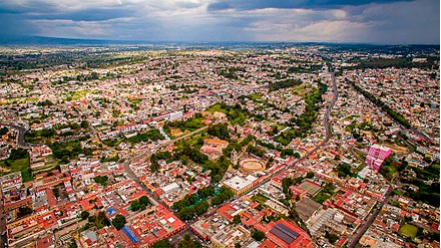
2. Natural geography
The main river in the municipality is the Zahuapan, which is part of the Balsas River region and the basin of the Atoyac River. Other rivers include the Huizcalotla, Negros, Tlacuetla and Lixcatlat. There are remnants of the former lake of Acuitlapilco as well. Other sources of fresh water include a spring in Acuitlapilco and a stream in Tepehitec which runs during the rainy season.
The higher elevations of the municipality have forests of pine, holm oak and white cedar. The mid range elevations are mostly secondary vegetation dominated by bush and low growing trees. The flat areas are dominated by a number of dry tolerate plants such as agave, nopal cactus and grasses. Because of the expansion of the urban area, the municipally only has small mammals such as rabbits, squirrels and opossums, along with some species of birds and reptiles as wildlife.
Weather
Köppen Classification: Oceanic Subtropical Highland Climate
The subtropical highland variety of the oceanic climate exists in elevated portions of the world that are within either the tropics or subtropics, though it is typically found in mountainous locations in some tropical countries. Despite the latitude, the higher altitudes of these regions mean that the climate tends to share characteristics with oceanic climates, though it also tends to experience noticeably drier weather during the "low-sun" season. In locations outside the tropics, other than the drying trend in the winter, subtropical highland climates tend to be essentially identical to an oceanic climate, with mild summers and noticeably cooler winters, plus, in some instances, some snowfall. In the tropics, a subtropical highland climate tends to feature spring-like weather year-round. Temperatures here remain relatively constant throughout the year and snowfall is seldom seen.Without the elevation, many of these regions would likely feature either tropical or humid subtropical climates.
The Köppen Climate Classification subtype for this climate is "Cwb". (Oceanic Subtropical Highland Climate).
The average temperature for the year in Tlaxcala is 60.8°F (16°C). The warmest month, on average, is May with an average temperature of 65.5°F (18.6°C). The coolest month on average is January, with an average temperature of 54.3°F (12.4°C).
The highest recorded temperature in Tlaxcala is 102.6°F (39.2°C), which was recorded in May. The lowest recorded temperature in Tlaxcala is 18.7°F (-7.4°C), which was recorded in December.
The average amount of precipitation for the year in Tlaxcala is 31.3" (795 mm). The month with the most precipitation on average is August with 6.3" (160 mm) of precipitation. The month with the least precipitation on average is January with an average of 0.2" (5.1 mm). In terms of liquid precipitation, there are an average of 108.1 days of rain, with the most rain occurring in July with 18.9 days of rain, and the least rain occurring in December with 1.2 days of rain.
https://www.weatherbase.com/weather/weather-summary.php3?s=766830&cityname=Tlaxcala%2C+Tlaxcala%2C+Mexico&units=
Getting there and around
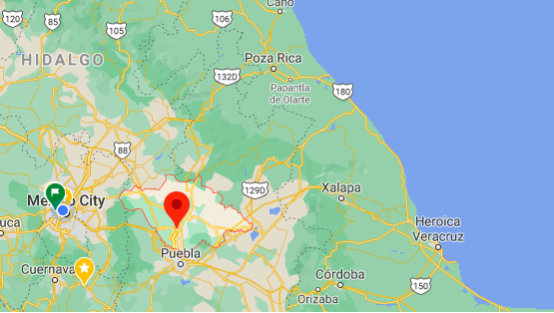
By car
The cheapest way to get from Mexico City to Tlaxcala is to drive which costs $220 - $330 and takes 1h 35m, plus the rental.
You can rent a car to travel to Tlaxcala from Mexico City or some other nearby city. The distance between Mexico City and Tlaxcala is 98 km. The road distance is 124.2 km.
One-way rentals are ideal if you are planning to fly out of a different city from the one you arrive in. They are a convenient way to take a longer, more extensive road trip and not have to back-track. On the flip side, some trips may make more sense to do as a round-trip drive. Compare availability and rates between various options and see what works best with your plans.
https://www.enterprise.com/en/road-trips/things-to-consider-when-renting-a-car-for-a-road-trip.html
By bus
Estrella Roja operates a bus from Mexico City TAPO to San Martín Texmelucan de Labastida every 3 hours. Tickets cost $120 - $230 and the journey takes 2h.
https://www.rome2rio.com/s/Mexico-City/Tlaxcala
Taxi
A taxi ride from Puebla takes 30 to 40 minutes and costs 280 pesos. The bus takes an hour, costs 18 pesos, and leaves every 15 to 30 minutes from a station on 6 Poniente, between 11 Norte and 13 Norte.
https://www.frommers.com/destinations/tlaxcala/planning-a-trip
Get around
Taxi - Taxis are a fairly convenient and safe way to get around the city. Be sure to call only verified taxi service. Before you get in a taxi make sure you know the way.
Uber is expanding rapidly across Mexico and now offers services in cities across the country, including: Mexico City, Toluca, Cuernavaca, Puebla, Querétaro, León, Aguascalientes, San Luis Potosí, Guadalajara, Monterrey, Hermosillo, Tijuana, Mexicali, and Mérida. Uber has been adding Mexican cities to its network every year, check for availability when you arrive at your destination in Mexico.
Cabify is developing also and currently operates in cities including Mexico City, Toluca, Monterrey, Puebla, Querétaro and Tijuana. Check for availability in the city you are visiting.
The services offers people with smartphones a way to book a cab through a mobile app for a pre-agreed price. Fares are comparable with Sitio type cabs (see above), and sometimes trade at a premium to this when local demand increases.
https://www.mexperience.com/transport/taxi-travel-in-mexico/#51
3. Economy
GDP: 14,861 M MXN
4. Industry
The traditional agricultural economic activity of Tlaxcala has given way, as in many other states of the country, to industrialization and the service sector.In the 2006 edition of the System of National Accounts of Mexico conducted by the National Institute of Statistics and Geography, the Gross Domestic Product of the state is made up of 50% by the manufacturing industry, highlighting the items of food and beverages; and the community, social and personal services sector.
The retail and tourist services sector, as well as real estate and financial services contribute 14% and 12.4% respectively. The agricultural sector, despite its reduced economic participation, generates the highest production of thorns and mint in the country, in addition to being an important supplier of roses, peaches, barley and grain wheat.
It is worth mentioning that in terms of employment, the government has worked to expand the labor supply, since around 40% of the population works in "non-formal jobs"; and 18% are employed in the field with incomes below two minimum wages in most cases.
The ground transportation infrastructure has been one of the great advantages of the state since the beginning of its urbanization. In 2004, it had a road network of 2,434 km and 351 km of railways. It is worth mentioning that Tlaxcala has an airport located 40 minutes from the center of the capital, in the municipality of Atlangatepec, and a heliport in the city of Tlaxcala.
5. Touristic sites
The capital of Mexico’s smallest state is unhurried and unself-conscious, with a compact colonial downtown defined by grand government buildings, imposing churches and a handsome central plaza. Despite its small stature, Tlaxcala is neither timid nor parochial. With a large student population, good restaurants and bars and a handful of excellent museums, the city has a surprisingly vibrant cultural life. Because there’s no single attraction that puts Tlaxcala on tourist itineraries, it remains largely undiscovered, despite its location less than two hours' drive from Mexico City.
https://www.lonelyplanet.com/mexico/east-of-mexico-city/tlaxcala
Museo de Arte de Tlaxcala
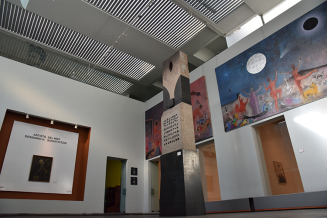
Its six rooms have high-tech lighting, security system and air conditioning. It has a permanent exhibition room with six works by Frida Kahlo and four rooms dedicated to temporary exhibitions of modern and contemporary art. It has a library and areas for conservation and research.
This fantastic small contemporary-art museum houses an excellent cache of early Frida Kahlo paintings that were returned to the museum after several years on loan to other museums around the world. Both the museum’s main building on the zócalo and the smaller branch hold interesting temporary exhibits and a good permanent collection of modern Mexican art.
https://www.lonelyplanet.com/mexico/east-of-mexico-city/tlaxcala/attractions/museo-de-arte-de-tlaxcala/a/poi-sig/1147334/361543
Nuestra Señora de Asunción Chapel
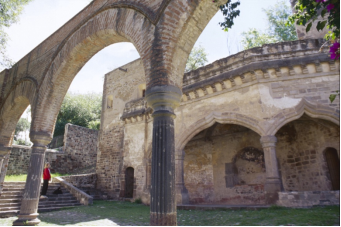
This portico-like structure, set in the back of Tlaxcala’s Franciscan monastery in Central Mexico, was used to preach to newly converted indigenous peoples in the 16th century. These “open chapels” are found in many of the churches of New Spain built by the evangelizing Catholic religious orders, the Franciscans, the Dominicans, and the Augustinians.
Most works of 16th-century religious architecture in New Spain were designed by the friars themselves, who often drew on European prototypes. But the actual masons, carpenters and laborers who built this open chapel and the adjacent church came from the indigenous community of Tlaxcala. Typically, communities were expected to provide the labor as part of their tribute obligations.
Through developing distinct architectural forms such as posas and open chapels, evangelizing orders like Franciscans attempted to create new spaces for public worship that would help them implant Christianity in formerly “pagan” indigenous communities.
https://vistasgallery.ace.fordham.edu/items/show/1800
Teatro Xicohténcatl
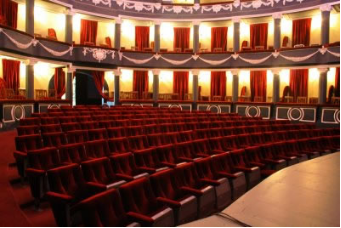
With a capacity for 320 people, the Xicohténcatl Theater is the ideal place for a weekend of theatrical experiences.
The theater is named in honor of the young Tlaxcala warrior, Xicohténcatl Axayacatzin, who opposed the alliance of his people with the Spanish conquerors.
It was inaugurated on May 5, 1873, with a representation of the battle of May 5. Over time it is said that it has had several renovations.
One of the changes was in 1923, when the old smooth mortar façade was demolished, where there was a central door and two side doors, which were replaced by another Xaltocan quarry façade.
But in 1945 it had another change in the upper floor, in which we can see a neoclassical style, with windows and iron bars.
Currently we can see that on its facade there are twelve columns that frame windows, doors and niches.
Other activities that take place inside are conferences, dance shows, music concerts, book presentations, recitals, to name a few. The theater is located on Avenida Juárez 21, in downtown Tlaxcala.
Once you leave the enclosure, you must walk to the Plaza de la Constitución where the Government Palace is located, a construction from 1545.
Inside you can see the great mural work of the Tlaxcala artist, Desiderio Hernánez Xochitiotzin, called “Tlaxcala through the times and its contribution to the Mexicans.
To end the day, a must see is the Stairs to the Heroes, which was built in 1960. It has 250 steps and a viewpoint where you can see a spectacular view of the city.
https://www.visitmexico.com/atractivo/teatro-xicohtencatl
6. History and Culture
The name Tlaxcala most likely comes from a Nahuatl phrase which means “place of corn bread.” The Aztec glyph for the Mesoamerican dominion is two hills from which emerge a pair of hands making a tortilla.
The site of the modern city did not have a settlement for most of the pre Hispanic era. The area was ruled by a coalition of four dominions called Tepeticpac, Ocotelolco, Tizatlan and Quiahuiztlan which united in the 14th century to defend themselves against the Aztecs and other enemies. In the fourteenth and fifteenth centuries, Tlaxcala was one of the most important areas of Mesoamerica with commercial ties to the Gulf of Mexico to the Pacific Ocean as well as Central America.
As the Aztec Empire grew, it conquered Tlaxcala's neighbors but left the dominion in order to perform annual ritual combat called the “flower wars” which aimed to not conquer but capture soldiers for sacrifice. The conquest of the surrounding area also cut off Tlaxcala's commerce. This remained the case until the arrival of the Spanish in the early 16th century. Hernán Cortés took advantage of this situation, enlisting the Tlaxcalans as allies against the Aztecs, giving them a base to attack from and regroup after the La Noche Triste when they were initially expelled from Tenochtitlan.
Despite the military alliance of the Tlaxcalans, they did not have a single capital. After the Spanish conquest terminated, the Europeans selected the current site to solidify their hold on the Tlaxcalans as well as have a base for evangelization. The most likely time that the city was founded was spring of 1522. Tlaxcala was the fifth diocese to be established in the Americas and the second in Mexico after Yucatán. The first bishop was Julian Garces and the seat was established in 1527. However, since there was a cathedral in the city of Puebla and not in Tlaxcala, the seat was moved to Puebla in 1539 and has remained there since. The original territory of the diocese included the states of Puebla, Tlaxcala, Veracruz, Tabasco, Hidalgo and Guerrero, but as new diocese were erected, the territory reduced to the present, states of Puebla and Tlaxcala. In 1903, the name of the Diocese of Tlaxcala was changed to the Diocese of Puebla.
At the time of the Spanish conquest, the Tlaxcala area was heavily populated but with epidemics, emigrations and the construction of the Nochistongo canal to drain the Valley of Mexico, most of the indigenous population disappeared. A document of 1625 states that there were 300,000 in the city in the 16th century but only 700 remained by that time it was written. The city was begun in 1537 with the construction of the San Francisco monastery. The city became the center of Tlaxcala identity during the colonial period. Its commerce was originally centered in the main square but was eventually moved to the outskirts of town. One important project that was traded here was the cochineal insect, used to make red dye. When New Spain was divided into five major provinces, Tlaxcala became the capital of one of them, with roughly the same dimensions as the pre Hispanic coalition of dominions. Tlaxcala was promised certain rights as an ally during the Conquest. When a number of these were not met, a codex was produced here called the Lienzo de Tlaxcala as a complaint to the Spanish Crown. However, despite the complaints, most of the indigenous eventually lost their lands around the city and lost many of their commerce rights in it.
In 1692, a revolt occurred against Governor Manuel de Bustamante y Bustillo due to the scarcity of grain.
The city of Tlaxcala became a municipality in 1813, under the Spanish Constitution of 1812.
French forces were forced out of the city in 1867 after which Tlaxcalan forces went with Porfirio Díaz to liberate Puebla and after that, Querétaro and Mexico City.
During the end of the 19th century, the politics of the city were dominated by Próspero Cahuantzi, who promoted public works such as kiosks, streets, public markets, bridges and government buildings. The city changed from oil lamps to electric light in the historic center, the state government palace was remodeled and the Xicohtencatl Theatre was built. Electricity for the city was generated through a hydroelectric works in a canal on the Los Negros River.
After the Mexican Revolution, the city recovered and began to grow again, reaching a population of 6,000 by 1927. In the mid 20th century, public education was enhanced at the middle and high school levels. More public works were undertaken to give the city the appearance it has today.
7.Contact Information
City Mayor: Anabell Avalos Zempoalteca
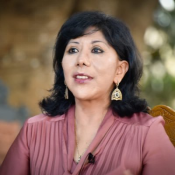
Contact number: +52 (246) 462 0014, ext. 420
Govt. Office Address: Portal Hidalgo No.6, Col. Centro C.P. 90000, Tlaxcala, Tlax.
Twitter: https://twitter.com/AnabelAvalosTlx
FB: https://www.facebook.com/AnabellAvalosZ
Website: http://www.capitaltlaxcala.gob.mx
E-mail: presidencia@capitaltlaxcala.gob.mx
